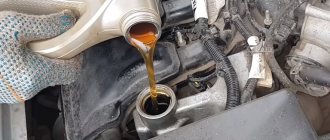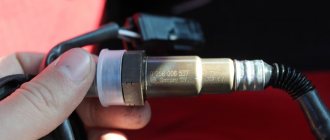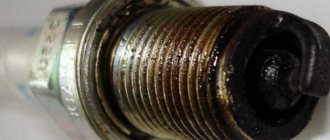Owners of different car brands, including LADA, are faced with the problem of oil appearing in engine spark plug wells. Why and where did the oil get there, and what to do about it? This is described in the plant's technological instructions.
When contacting the dealer, specialists will remove oil from the wells using rags and a solvent (for example, Nefras S2).
Next, to confirm the formation of oil in the spark plug wells, you will be asked to perform a test run of 1000 km. If after this the appearance of oil is again detected in the spark plug wells, the issue of engine warranty repair will be considered.
Summary
The reasons for oil leakage in the spark plugs of the sixteen-valve power plant of the Lada Granta are a loose connection of the valve cover to the camshaft bed and/or the camshaft cover to the cylinder head. A malfunction increases the risk of fire and leads to failure of the ignition coil and spark plug.
Treating the joints of the mating parts of the cylinder head with an anaerobic sealant helps prevent leaks. To apply the sealing compound, it is necessary to disassemble the parts and prepare the surfaces. When reassembling, be sure to replace the receiver seals and use a torque wrench.
“Ten”, in comparison with its brothers, has many differences, which lie in the design features of the engine. In addition to constructive ones, there are other, more unpleasant differences in the malfunctions inherent in the tenth generation VAZ.
So one of the “pain points” of the tenth generation can be considered the appearance of oil in the spark plug wells, which gets into these places largely due to problems with the gaskets. In this article we will talk about why this happens, where the oil in the spark plug wells comes from, and how to fix it.
What else you need to know
Most car owners make one big mistake when making repairs - they forget about the spark plugs. As we remember, a candle in a flooded well will have two states:
– in oil – in soot and in oil
As you might imagine, excess buildup on a candle will have a negative impact on its performance, so it is of utmost importance to clean the candle before reusing it. For cleaning, you can use a “carburetor cleaner”, which is good at removing unnecessary deposits.
Since this problem is a feature of the Granta design, there is an opinion that the engine should be opened only in the event of a major drop in compression. In part, this is justified, since in the absence of any serious changes in the operation of the car, this will mean a small amount of oil in the pads, which can only affect a decrease in the service life of the spark plug.
Why is there oil in spark plug wells?
As I said earlier, a design feature of the 10th generation engines is the poor tightness of the valve cover, through which the oil actually enters the spark plug wells. A feature of the 10th generation engines with a volume of 1.5 liters is the presence of sealing rings on the guide tubes (cups); engines with a volume of 1.6 liters do not have this feature due to the fact that their well is part of the header. Removable windows are also found on VAZ 2110-12 models produced after 2002.
How to solve a problem?
In most cases, the solution to the problem of oil getting into the spark plug wells on 1.6L engines is to remove the valve cover, add a quality sealant and reinstall the cover. If you have a 1.5 liter engine, but you also find oil in the spark plug wells, then in this situation the problem in most cases is associated with wear of the oil seals, they are also called gaskets or gaskets. O-rings are installed in the upper and lower parts of the spark plug wells; there are 2 seals in each glass, that is, there are 8 in total. The solution to the problem is to remove the oil from the wells, then the oil should be replaced with the spark plug well seals.
What can this malfunction lead to?
The first thing that will suffer is the power output. If you imagine a car engine as a heart, then imagine that one of its “heart” valves has stopped performing its function. It turns out that out of 100 percent of the power you will receive only 75, or even less, since the remaining spark plugs will be subject to an increased load, which sooner or later will also cause them to fail. Thus, malfunctioning spark plugs:
– increases wear on other engine components
(Everything that is affected by oil in spark plug wells must also be checked during repairs).
– reduces the technical performance of the car
How to replace well seals on a VAZ 2110?
The principle is something like this. The valve cover is removed along with everything that may interfere with operation, then the wells are pulled out. The spark plug well seals are cleaned and replaced. The whole process is quite complex, so this job will take three to five hours to complete, depending on your skills.
The main problem with this procedure is the extractor, which must be made or purchased. The tool for removing the cover consists of a pin (about 15 cm long), a piece of tube with a diameter of 2.4 cm, several suitable washers (as close as possible to the diameter of the cover) and 3 nuts. Assembling the extractor: first you put a washer on the pin, then there is a tube, then another washer, finally a bushing and nuts complete the design of the makeshift extractor.
The hood works according to the following principle: when the nut is tightened, the pipe contracts and begins to “expand” the well. With a little effort, remove the entire glass of the candle.
The main thing is to make sure that the spark plug well seals are installed correctly, you also need to make sure that the valve cover is in place.
For more information on how to replace spark plug well seals on a VAZ, watch this video
It is known that the engine and its systems have various seals and gaskets in their design that provide the necessary tightness at the joints of individual parts and elements. This gasket allows you to seal the joints, eliminating the loss of engine oil and other technical fluids.
At the same time, during the operation of the car, the owner may often encounter the fact that the oil still begins to leak. In some cases, the lubricant actively contaminates the engine from the outside, oil gets into the spark plug wells, flows out from under the oil filter, leaks through the camshaft or crankshaft seals, etc.
It is important to understand that oil leaks not only lead to an increase in lubricant consumption and pollute the internal combustion engine, but also cause various breakdowns, that is, they affect the operation of the engine. One of these common problems is the detection of oil in spark plug wells. Next we will talk about why oil gets into the spark plug wells and how to fix such a leak with your own hands.
Read in this article
Oil in spark plug wells: cause of malfunction and possible consequences
Please note that the appearance of oil in the area of the spark plug shaft is quite common in some internal combustion engines. Next, let's look at the problem using the example of 16-valve engines installed on the domestic Lada Priora model.
It should be separately added that such a problem can occur both on used cars and on practically new vehicles. In this case, this malfunction should be corrected immediately, since oil getting into the wells can lead to more serious complications.
The presence of oil in the spark plug shaft leads to softening of the rubber elements (spark plug insulator, high-voltage armored wires). As a result, sparks occur, misfires in the cylinders, the engine starts poorly, stalls and loses power. In the future, various elements of the ignition system (coil, spark plugs, etc.) may fail.
Such malfunctions can cause the engine control unit on the instrument panel to ignite; the engine requires constant computer diagnostics and error reset, not to mention the reduced life of the spark plugs themselves, explosive cables and other parts.
So let's get back to the reasons. To begin with, oil usually gets into the spark plug wells through leaking valve cover gaskets or spark plug seals. Many engines have a rubber gasket mounted under the valve cover to seal, and various types of sealants (anaerobic, silicone, etc.) have also become popular recently.
The gradual drying of the sealant, errors in its application and the use of low-quality compounds lead to the fact that such a sealant begins to leak much faster than a conventional gasket. Owners of the Priora model noted cases when oil appeared in the spark plug wells even on new cars. The fact is that during the long downtime of the car in the car dealership, the sealant simply had time to dry.
For what reasons does soot appear on candles?
Now it is possible to use many methods when diagnosing a car and its engine. The most common are:
However, one of the ways that can accurately indicate the occurrence of malfunctions in the engine is the appearance of carbon deposits on the spark plugs, the cause of which lies in the engine.
What does the appearance of carbon deposits on candles indicate?
By examining the appearance of the removed spark plugs, a specialist can easily determine the current condition of the main power units, as well as malfunctions in the operation of the vehicle’s auxiliary components and systems.
Depending on the color and degree of carbon deposits observed on the spark plug, auto mechanics accurately determine the diagnosis of the engine. At the same time, an understanding is formed - the engine operates primarily on a rich or lean fuel mixture. Also, a different color shade of soot on a set of spark plugs indicates specific reasons for poor engine performance.
The main malfunctions include:
Advice: in order to see the reason for poor engine performance, you don’t always need to go to a car service center. First, remove the set of spark plugs from the cylinder block and look at the color of the carbon deposits that appear. The indicator symbols on the instrument panel will also indicate problems with the engine.
What does the color of soot deposits indicate?
Using a color shade, you can quickly understand what problem areas are in the engine of your car. However, simply replacing samples will not solve the cause of soot - new spark plugs will very quickly become unusable. Currently, there are 3 main colors of deposits in the ignition system.
Each of the colors presented indicates the occurrence of a specific malfunction or group of problems in the car’s engine.
The appearance of black soot
This plaque can be either dry or oily. The appearance of a black coating in dry form indicates that an enriched mixture is being supplied to the engine. Candles become covered with such soot as a result of:
This is interesting: Step-by-step instructions on how to reset service intervals for cars yourself
If black oily deposits appear, it is necessary to check the possibility of oil getting into the combustible fuel mixture itself. As a rule, oil leaks as a result of wear of the oil scraper type piston ring set. In addition, the cause of oil deposits can be damage to the valve system caps.
Advice: if you have recently repaired a VAZ-2114 generator, be sure to check the spark plugs. Perhaps some of the problems with the car lie there.
Self-fixing oil leaks in spark plug wells
Taking into account the above information, it becomes clear that for normal operation of the ignition system, it is necessary to eliminate even a small leak that leads to oil accumulation in the area of the wells. However, not all drivers know what to do if there is oil in the spark plug wells. Let's figure out how to remove oil from spark plug wells and make such repairs yourself.
Let us immediately note that although this is a simple procedure, without certain skills it will still be correct to contact a service center and entrust the car to specialists. If you solve this problem yourself, you will need:
- remove the intake manifold;
- remove the timing belt cover;
- remove the timing belt;
- remove the valve cover;
- remove the camshaft from the frame;
These works will allow you to gain free access and completely remove the old layer of sealant from elements and surfaces, as well as apply a high-quality fresh composition. Please note that the old sealant must be completely removed. Any residue may interfere with subsequent sealing of parts with a new composition. In this case, the entire complex of work will have to be carried out again.
As a result, oil leaks will continue, further air leaks may occur, etc. For this reason, old sealant is removed using chemical solvents. For this, use acetone, white spirit or regular gasoline. A small piece of cloth is soaked in solvent, after which the old sealant is carefully removed from the surface.
Fresh sealant is then applied to the surface of the valve cover and reassembled. As for the sealant itself, an anaerobic sealant is best suited for this purpose. During assembly, it is also important to consider the order and torque of the mounting bolts when installing the valve cover.
Additional Information
Do not forget that the manufacturer strongly recommends changing spark plugs every 30 thousand km. To achieve the best effect, after completing the removal of oil from the spark plug well, it is advisable to blow it out. This allows you to eliminate various components that may affect further functionality (dirt, dust, remnants of tissue matter).
Thus, if you discover a malfunction of your Granta, in the form of flooded candles, do not despair! This problem can be solved with low costs and direct hands. The main thing is not to start the problem. If troubles caused by the lack of necessary tightness are resolved in a timely manner, it will not bring any consequences to the condition of the machine.
Hello everyone, today when I was unscrewing the spark plugs I discovered oil in the spark plug wells, namely in the fourth one! So people read that on 1.6, like mine, O-rings are not installed, but the place where the valve cover fits is coated with sealant! please tell me if this is true) thanks in advance
Comments 60
Wait for it to start firing, the tip will break through, the spark plug needs to be replaced! So, it’s better to do it right away!
strange, I went to do something today, arrived, unscrewed the coils and it’s dry there
My situation is a little different, after spinning the engine up to 5k rpm, traces of oil appeared between the cylinder head and its cover, mainly in front, can this problem be cured by simply pulling it? the car is new
sealant as written above and I can also recommend done deal grey. There is nothing dangerous except 1) the spark plugs often fail 2) it can get damaged 3) the rubber bands on the modules burst (there is a shortage in Ryazan) and without them it breaks again and again fails. Yes, if you do it yourself, then don’t forget to crank the engine with the starter, but without spark plugs to avoid water hammer from leaking oil into the cylinders))) and start it not in a garage but in a well-ventilated place))) there will be smoke...))) from personal experience I say)
Useful tips
As you can see, replacing the sealant under the valve cover is not difficult. The main requirements are thorough cleaning of the old layer and proper application of fresh sealant to the surface.
The applied layer must be uniform, interruption is not allowed. It should also be taken into account that the joints between the joints of the spark plug wells must be treated with sealant, having first removed the old sealant from there.
If only one engine needs to be repaired, a tube of heat-resistant sealant is sufficient. You can also read about choosing the best engine sealant in our separate article.
It should be noted that the use of sealant if the valve cover on a particular internal combustion engine is installed through a rubber gasket is undesirable. In this case, you need to purchase a new high-quality gasket, after which the mating surfaces are checked. Next, a new valve cover gasket is installed, after which the valve cover is tightened, taking into account the order and torque of the fasteners.
What's the result?
- As a rule, it is possible to solve the oil problem in candle wells with minimal financial costs. Even if you buy an expensive professional sealant, the price for a small pipe will still be quite affordable.
- We would like to add that at the initial stage, in some cases, replacement of spark plugs is not required, but separate cleaning of spark plugs may be required. Only after removing dirt and carbon deposits will the power unit operate stably and smoothly.
- If mistakes were made during sealant application, oil leaks may persist in the future. For example, anaerobic sealants only cure when they are not exposed to air. It turns out that if it is not possible to achieve perfect adhesion of the surfaces, the composition will remain liquid and the seam will not be sealed.
Why does oil leak from under the gasket or valve cover body: causes of lubricant leaks. How to fix an oil leak from under the valve cover yourself.
Why oil leaks from the engine breather: the main signs and causes of such a malfunction. How to understand why oil comes out through the window, troubleshooting.
Causes of oil leaks in the oil filter area: Oil flows from under the filter, through the housing, into the connection area, etc. Available diagnostic and repair methods.
Because engine oil begins to drip or leak at the intersection of the engine and transmission. How to accurately determine the cause of a lubricant leak, how to diagnose and repair.
Crankshaft oil seal leak: how to determine the location of the leak yourself. Why does the current crankshaft oil seal need to be changed urgently, for example, the front and rear oil seals need to be changed.
Gradual or sudden increase in diesel fuel consumption. Possible malfunctions, diagnostics and solutions.











